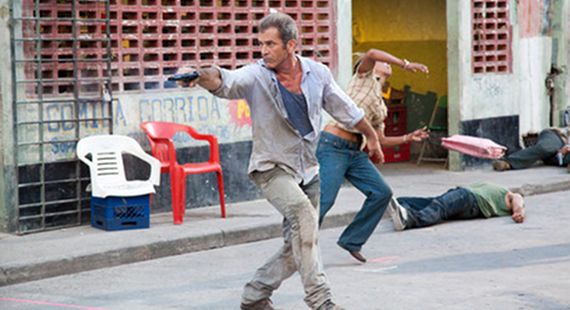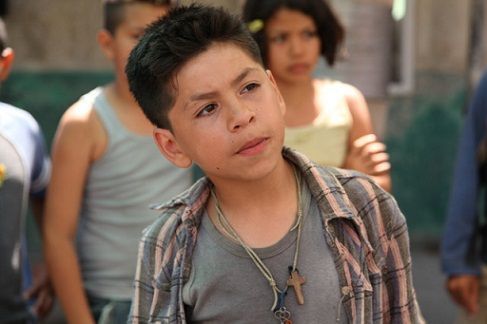Get The Gringo (also known as How I Spent My Summer Vacation in some international markets) has just been released on DVD and Blu-Ray following an interesting release pattern on DirecTV and VOD. The film has achieved good reviews (read ours), with many calling it a return to form for its star (and co-writer and producer) Mel Gibson.
Screen Rant spoke with the film’s director Adrian Grunberg , a former Assistant Director who is making his directorial debut with the film. Grunberg talks about working with Mel Gibson, as well as discussing what it’s like directing an old-fashioned action film in Mexico.
Tell me about the genesis of the script. Were you attached to the film as a writer first or as a director?
You say attached, which is a very industry word. This movie was not very industry like. I was offered the movie by Mel, in his office one day. He came to me and said 'I have this idea for a movie about a gringo in a Mexican prison and I think you should direct it,' and I said 'Awesome.' A couple of months later, we started getting together on a monthly basis to throw ideas around and write the script. So, it was together. He wanted me to direct and he wanted me to co-write it with him and Stacy.
You’ve been first assistant director on quite a few films – what made you decide that this was the movie to make the leap into directing? And how did your previous experience help you?
The reason I decided was because Mel offered it, and that’s an offer you can’t refuse. Mel offered me the chance to direct and there was no way I was going to say no. Not only because it was Mel, the actor, but it was a guy who I’d been working with for the last few years. I enjoy him as an actor and I enjoy him as a director. In terms of how my experience helped me – it was the understanding of the psychology, how a set breathes and lives on a daily basis. That’s the experience that I’ve had for many years as an assistant director. As as a crew member you get to work with many different directors - as a director you never get to work with another director again. So I was able to cherish these jobs where I was able to work beside Oliver Stone, Mel Gibson, Tony Scott, Jim Jarmusch. Those are people I admired for years.
You live in Mexico – was it your idea to set the film there, or did that work its way out of conversations with Mel Gibson and Stacy Perskie?
When Mel first mentioned the project for the first time, he had this idea about a gringo into a Mexican prison, so right off the bat the idea to set it in Mexico was there. I think that was probably the reason he chose me to direct it. It built perfectly on everything.
How much research was needed to make the world of the film seem real?
A lot. The research was crucial to the script and the more we found out about this place, El Pueblito, the more opportunity to write scenes in an interesting setting. You have a man and woman talking to each other watching a wrestling match – it’s visually more interesting than just talking in a corner. So what the research gave me was the ability of writing these scenes in very specific, cool places and there are characters and events in the movies which are based on the research as well. The raid at the end of the movie is based on one of the things which happened in El Pueblito.
Kevin Hernandez gives a great performance as "The Kid." How did you go about casting him, and how did you get him to give such a good performance alongside Mel?
The casting process was a bitch. We did massive, massive casting in Mexico, and all over the country, we saw thousands of kids and nobody had ‘it’. This kid had to have ‘it’. It was one of those desperation moves – I called this friend of mine – she’s a casting director, she’s Mexican, but lives in LA and I said, ‘We’re looking for this character and I can’t find it. Do you have anybody?’ She said, ‘Look I just finished doing the casting for another movie and I have this kid who’s amazing.’ She sent over the videotape of something else and immediately we loved him. We brought him over. The guy’s just a confident kid. You know, he’s confident in himself and he’s very well brought up. His parents are regular, humble people and I think that says a lot – the way that you bring up your kid. He’s just a good, big-hearted kid, with a big boost of confidence.
The world of Get the Gringo looks very real and it was shot on location. How much of it was authentic and how much was production design?
We shot in a real prison, so a lot of the sets were already there. The look of this place was there. But Bernardo Trujillo, who was the production designer had to create this place - El Pueblito - and there was a lot of work that he and his department had to do, which was spectacular what they created, because it looks real, it looks used and it looks decadent. It was very well-conceived and designed. My heart goes out to him and his crew.
What challenges did you face when making the film?
None different from any other movie. I was at the helm now, so what I did was surround myself with really talented people, who were also friends and they lifted me up.
Get the Gringo is not only a throwback to older action pictures, but it’s also got a strong western vibe. It was warmly embraced by the critics – do you feel that people are getting fed-up with too many special effect spectacles and want something a bit more grounded?
I can only hope so. I don’t know if that’s what they want, hopefully there is a market for it. It’s a different kind of movie, nothing that hasn’t already been done before, but maybe reminiscent of something of sometime in the past.
The action sequences are very well choreographed – is this something that you plan in advance – or do you get to the set and try to figure it out and then work it together in the editing room.
You need to have a plan going in and you need to have a base of what you are going to do. The you can allow that to organically change and add to it, but you do have to start with a pretty clear idea. You can spend weeks shooting and you don’t have that luxury.
The film had an interesting release approach. How involved were you in this and do you see it was the way that films will be released in the future?
I wasn’t involved at all. This was a Mel and Icon decision. I think it was a gamble and I think that Mel has in the past used alternate methods of distribution. I think that it’s a bold move and I hope that it pays off for him and for me. I definitely think that it is a big part of the future, whether or not it’s part of the present? That’s still to see. We’ll see how the movie went.
What’s next for you as a director?
A lot, I hope. I’ve been reading scripts. I’m starting to write a few things as well. But so far I don’t have news about anything coming up.
-
Get The Gringo is now available on DVD/Blu-ray.


